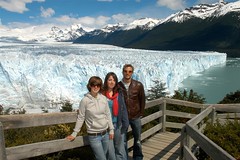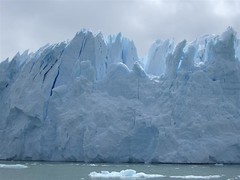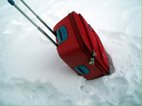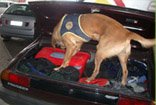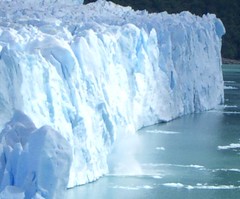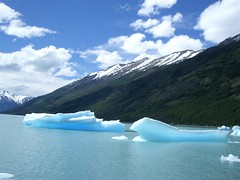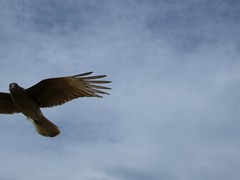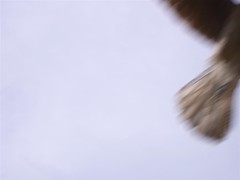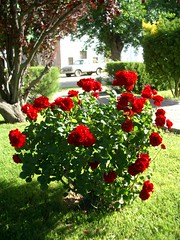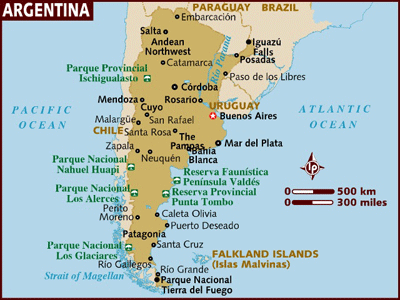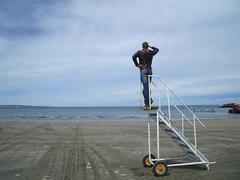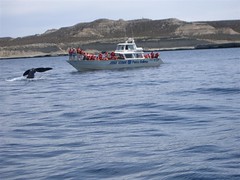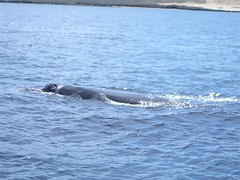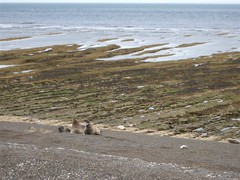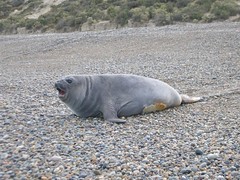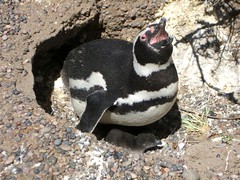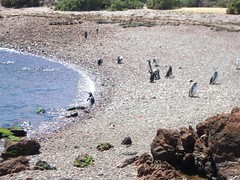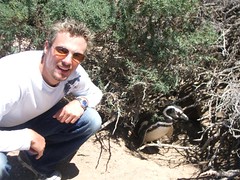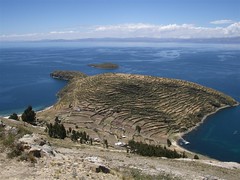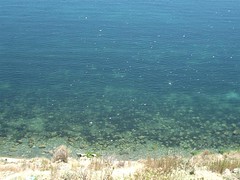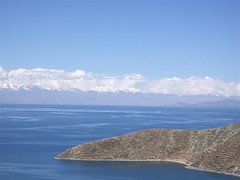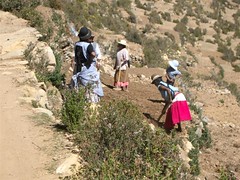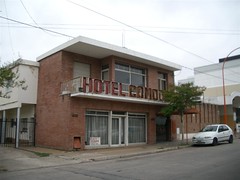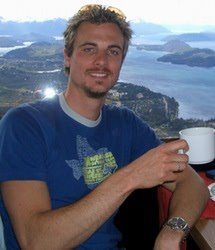From La Paz I headed to the town of Copacabana, on the shores of Lake Titicaca, which straddles the border between Bolivia and Peru. Maybe not "the hottest spot North of Havana", as sung by Barry Manilow - I think he was referring to the more famous Copacabana beach in Rio de Janeiro, Brazil. They say that the Copacabana in Rio was named after this Copacabana.

Crosses atop the hill overlooking Copacabana and Lake Titicaca
At around 3800m Lake Titicaca is said to be the world's highest
navigable lake. It's big enough - 180km long and 90km wide. Lake Titicaca was believed to be the birthplace of the sun by the Inca people, as well as all sorts of other spiritual things - the earth's vagina, with Mt Everest being its penis. It depends which tour guide you talk to, they'll tell you anything to keep you listening. Whatever, I needed to chill out after La Paz and a bit of Titicaca action was just what I needed. A gorgeous sparkling blue lake, sparkling so because of the altitude, a lakeside beach (although the water's too chilly to swim in), lots of good restaurants, and best of all - fresh trout! The trout was the best fish I've ever tasted, because it was so fresh - taken from the lake that morning. I had trout for just about every lunch and dinner. I splashed out and stayed at one of the nicest hotels in town, the lakefront Hotel Mirador, for only $40Bs (US$5), I think it was so cheap because it was still being constructed.
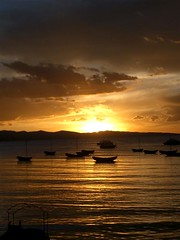
Sunset over Lake Titicaca
My 30 day visa for Bolivia was almost expired, so a visit to immigration was necessary to get an extension. But knowing what a hassle that can be to get done in Argentina, I figured in Bolivia it would be even worse - so I decided to cross the border into Peru and then re-enter to get me another 30 days. I found out later I needn't have bothered, an English friend told me the immigration in La Paz gave him an extension quickly and easily... oh well.
So from Copacabana I caught a tourist bus to Puno, in Peru, stopping at the border on the way. On the bus a lady was selling tours of the floating islands near Puno, which I planned to visit, so I signed up. Half our bus were visiting the floating islands, the other half were carrying on to Cuzco, in Peru. Cuzco?, I thought. Hmm, that's close to the famous Lost City of Machu Picchu. I was due to head back to Argentina in about 2 weeks so hadn't planned on visiting Machu Picchu or Peru at all, but now I was only a 7 hour bus ride away from Cuzco. Maybe I could give Machu Picchu a flying visit... but I didn't have any clothes, just the clothes on my back and a small bag with my camera recharger and a change of socks, as I'd only planned on visiting Puno and then returning the next day to Copacabana. Didn't even have a guidebook. I thought it over for the rest of the bus ride to Puno and decided to do it!
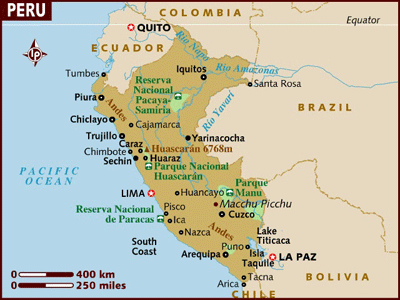
Map stolen from www.lonelyplanet.com
But first we were to visit the floating islands of Puno, which were interesting themselves. The Uros people construct these islands by binding together layers of reeds. Obviously they didn't grow food so they lived a fisherman existance, living on their island and trading fish for fruits and vegetables with the Incas. Nowadays there's 40 of the islands, as whenever there's a family feud or whatever they cut off a piece of island and tow it to somewhere else in the lake! The islands are about 2 meters thick and do indeed float - so they're held in place by long poles anchored to the lakebed. During the rainy season they have to tow their islands to shallower parts of the lake or risk floating away.
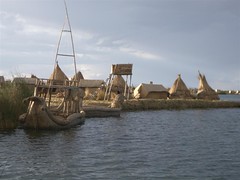
Reed island, reed boat, reed house, reed tent, reeds for breakfast
They constantly replace the layers of reeds from the top as the underwater layers rot away. They use those reeds for everything - they even eat them raw for breakfast. I tried a reed, peeling it like a banana, but it tasted like nothing. An interesting way of living they have. Only two of the smaller islands are open to tourists visiting (and live off souvenir sales), the rest prefer to carry on living quietly as they have for the past few hundred years.
So, on to Machu Picchu, the famous Lost City of the Incas which wasn't discovered by the Spanish until 1911... by an American. From Puno I caught a 9pm night bus to Cuzco, arriving at 5am... taxi to another bus station... bus to the town of Ollantaytambo... arrived at 8am, was told the next train to Machu Picchu would leave at 9.05am. Had a decent breakfast before walking to the train station... a queue to buy a ticket. The prick in front of me had a big list of names, evidently buying tickets for a tour agency. I watched the train leave the station whilst I was waiting for the guy in front of me to finish buying tickets - I couldn't believe it. The next train was at 10:30am which meant an hour and a half of waiting and an hour and a half less time at Machu Picchu. By the time I caught the 10:30am train I was still fuming about the guy in the queue and the special "foreigner price" for the 2 hour train trip (US$34 one way for 3 hours- a 17 hour train trip in Bolivia cost US$17 in first class), that I didn't even want to go to stupid Machu Picchu anymore.
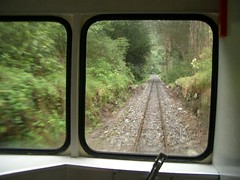
The train to Machu Picchu
I was soon blown away by how green everything was - being in the start of the wet season. I was used to the brown empty windswept plains of Bolivia's altiplano. Here at around 2400m altitude everything was a lot greener, and wetter. It seemed to be raining all morning.
The best way to get to Machu Picchu is to do the 4 day Inca trail trek. Still, the train passed the trek's campsites and large parts of the trail, so I at least got to see a bit of what the 4 day trek is like. From the train we could see trekers or porters trudging along in the rain on the trail.
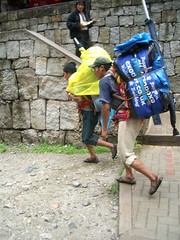
Peruvian porters. Strong buggers
Finally the train arrived and I was keen to get there, but from Aguas Calientes it's still a way to get to the ruins. The bus charges US$6 for the 20 min ride to the ruins. To put that in perspective, I could buy a 6 hour bus ride in any other part of Peru for that much. But as with the train (and the 4 day Inca trek) they suck the money out of the tourists. But that's what you get when you go to probably the most popular tourist attraction in South America. So I decided to walk up, figuring I'd get a taste of the 4 day Inca trail along the way. If I'd have known what I was in for I would have taken the bus and walked down instead! What I had was 2 and a half hours of this:
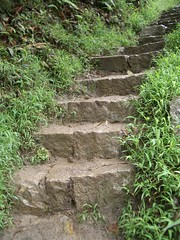
2 and a half hours of this
I definitely got a good taste of the Inca Trail, at least Day 2 of it which I'd heard was 6 hours of steps.
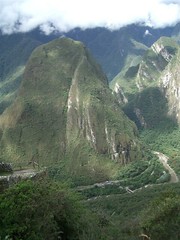
I started walking from around the corner, by the river
The town of Aguas Calientes where the train ended is alongside the river on the other side of that mountain in the photo above. From where I've taken the photo I'm at about the same height as the mountain.
Finally I arrived at Machu Picchu itself, at around 3pm. Straight into the middle of the ruins.
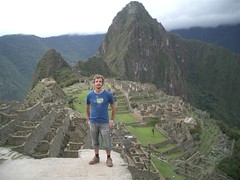
Me and yesterday's clothes at Machu Picchu
From there I treked another hour or so up the official Inca trail, to the Sun Gate, which is where the trekers get their first glimpse of Machu Picchu, after 4 days of treking.
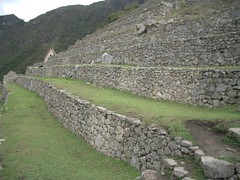
Terraces
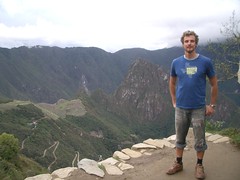
View from the Sun Gate. You can see the bus' road below
At the Sun Gate I met a tour guide leading a group of American girls on a tour and he said I could join their tour group the next morning at 6am for a guided tour of the ruins. I would have liked to do it to learn more about the place, but I'd already booked my return train ticket for the next morning.
So the next rainy morning (NB. for those planning on visiting in October: it poured down all night and morning) at 5.45am I was back on the train to Ollantaytambo, then back on the bus to Cuzco.
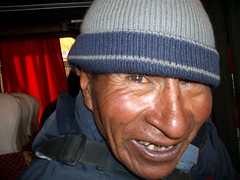
Peruvian geezer next to me on the bus to Cuzco
I knew I couldn't make it back to the cross the Bolivian border from Cuzco before the border closed at 6pm, so rather than camp a night at the border I decided to spend the daytime checking out Cuzco and catch a night bus to the border that night. Cuzco has a reputation for being a great traveller's hangout, so I spent the rainy afternoon wandering around, just to get a taste of it.
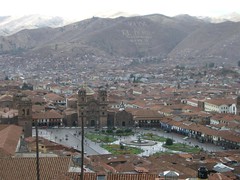
Cuzco's Plaza de Armas on a rainy afternoon
Although a beautiful city with some nice colonial streets and buildings reminiscent of say Sucre in Bolivia, to me Cuzco felt too touristy. Because it's the gateway to Machu Picchu, there's heaps of tourists. More annoying is there were too many people in the streets trying to get money out of the foreigner - by shining shoes, selling drugs, selling tours, selling hippie bracelets, being a tour guide. And if you give them some they ask for more. The shoeshine boy told me he needed a big tip so he could go to the football game that day. He really sold it, saying it was a big game and if he could have a big tip he'd be able to go. He suggested I check out the stone of 2 angels, which I went on a wild goose chase for. Turned out I'd misunderstood the translation - it wasn't the stone of 2 angels but the stone of 12 angles - a brick in a wall which instead of being a regular square was cut in 12 angles. Big deal! Didn't even waste a photo on that one. Of course, there was a local guy on hand to tell me the history of the stone for a tip, which I gave him, but he wanted un pocito mas (just a bit more).
Finally caught the night bus out of there and crossed the border back to my beloved Copacabana on Thursday morning, and it was just as I'd left it on Monday at midday. I spent a couple more days there recovering from my 3 days in Peru, well in Peruvian buses. That's the first time I've ever travelled so fast, yet many people come to South America and travel like that for a month (Hi Trent!). I couldn't do it.
